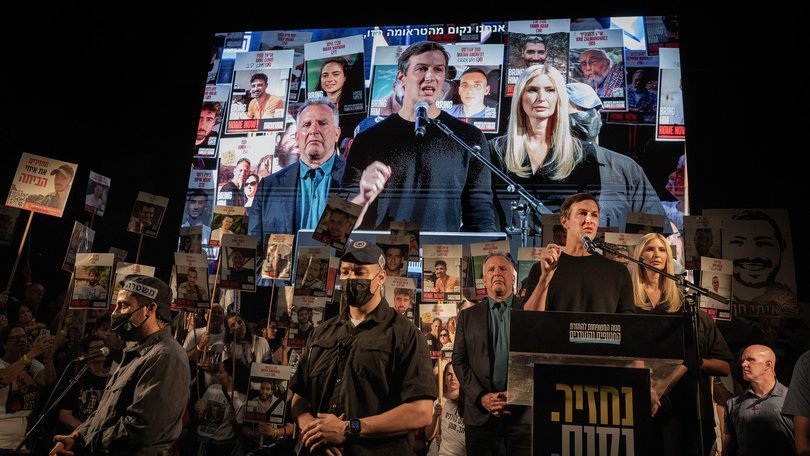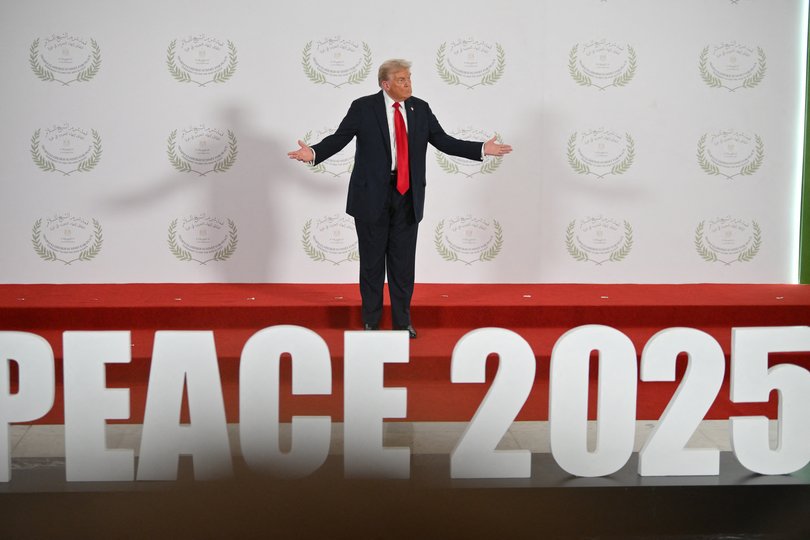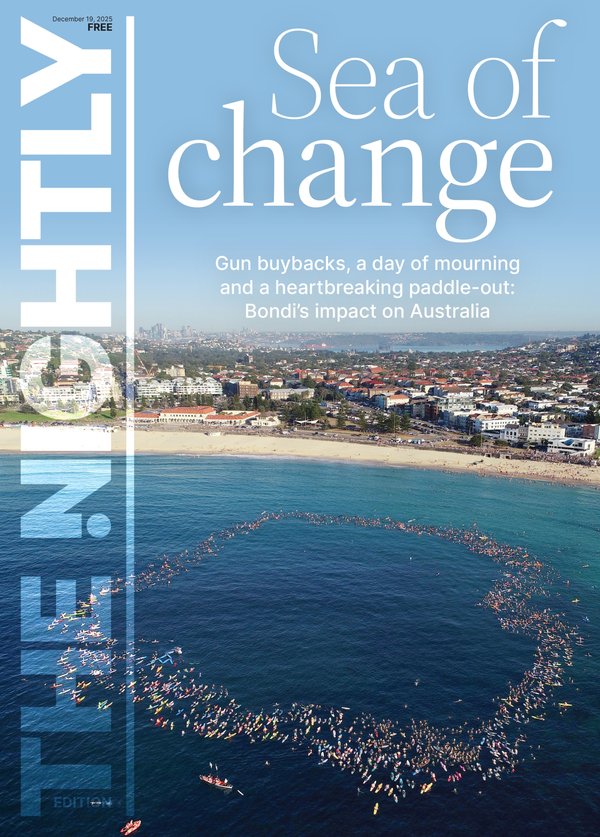Gaza ceasefire: How the US and the Arab world teamed up to seal the Middle East peace deal

The Egyptian intelligence chief was briefing a roomful of negotiators on the state of play in the Gaza Strip ceasefire talks when the Prime Minister of Qatar quietly slipped a handwritten note to Jared Kushner and Steve Witkoff.
The note urged the two Americans to push the Israelis to compromise.
It was the morning of Wednesday, October 8. Mr Kushner, President Donald Trump’s son-in-law, and Mr Witkoff, the US special envoy to the Middle East, had just arrived on a private plane in Sharm el-Sheikh, Egypt, for what they hoped would be a breakthrough, at last, in the negotiations to bring an eventual end to Israel’s two-year war with Hamas in the Gaza Strip.
Sign up to The Nightly's newsletters.
Get the first look at the digital newspaper, curated daily stories and breaking headlines delivered to your inbox.
By continuing you agree to our Terms and Privacy Policy.They had reason to be optimistic. For the first time, Hamas had signalled its readiness to release all the Israeli hostages without a complete withdrawal of Israeli forces and as long as it received assurances that Israel would not return to war. Giving up the hostages could deprive Israel of a reason to carry on the war. And Israel was ready to free thousands of Palestinians from its prisons, including 250 serving life sentences.
But the talks were jammed.
Negotiators who had been meeting for two days at the resort town’s international convention centre had shied away from pressing Israel and Hamas on a thorny question: how much territory in Gaza the Israeli military would leave before the hostage and prisoner exchanges. They feared that getting into the details of the map could derail the talks altogether.
This account is based on interviews with 15 officials from the US, Israel and Arab governments involved in or briefed on the negotiations, all of whom insisted on anonymity to discuss private conversations and sensitive diplomacy.
Both Israel and Hamas had taken maximalist positions. Hamas wanted Israel to pull out of Gaza entirely except for a narrow buffer zone along its border. Prime Minister Benjamin Netanyahu wanted Israeli troops to stay entrenched in some cities in Gaza to show his public and his hard-line ministers that he was making few concessions.
Bridging that gap last Wednesday required steady American pressure on the lead Israeli negotiator, Ron Dermer, officials said, as the Qatari premier’s note had urged. It also took three calls to the mediators from Mr Trump himself, US officials said.
Mr Dermer’s office declined to comment. Hamas did not respond to a request for comment.
Ultimately, the two sides more or less split the difference, Arab officials said. Israel would hold on to much more territory than Hamas wanted it to, but it would pull out of many built-up areas.
Hamas grudgingly accepted the compromise, Arab and Israeli officials said.

The mediators also knew that negotiating an agreement focused on the narrower issues of a ceasefire and hostage and prisoner exchange was more attainable than pushing for a grand deal that dealt with difficult questions around Israel’s full withdrawal from Gaza and Hamas’ disarmament.
The success of last Wednesday’s talks, where earlier attempts had failed, reflected how, once enough pressure had been applied, seemingly huge impediments could be overcome, or at least set aside for later. In the past, the two sides had fallen back on absolutes. Israel insisted on “total victory,” and Hamas on a total Israeli withdrawal from Gaza.
A big complaint from mediators about Israel in prior talks was that its negotiators never really had a mandate from Mr Netanyahu to make a deal.
This time, the leaders of both delegations — Khalil al-Hayya, the top Hamas negotiator, and Mr Dermer — came with a mandate to reach a deal, Arab and Israeli officials said.
The talks were the culmination of dizzying weeks of diplomacy that began after the fallout over Israel’s botched strike against Hamas officials meeting in Qatar. By late September, Mr Trump had announced a 20-point plan that, while short on many details, specifically called for the release of all hostages in exchange for an Israeli pullback in Gaza.
Crucially, on October 3, Mr Trump chose to embrace Hamas’ statement on his Gaza plan, even though it only offered support for part of his proposal, namely the exchange of hostages and prisoners. At the same time, he made clear that Israel would need to cooperate with his effort to strike a deal or risk facing his wrath.
Israel’s botched strike in Qatar had created an opening to apply such pressure. But a senior US administration official credited Mr Trump’s long-term approach to Mr Netanyahu with allowing him to prod the Israeli leader in the direction of a deal. His staunch support gave Mr Netanyahu confidence, the official said, that Mr Trump would not ask him to do anything that would compromise Israeli security.
As for Hamas, two years of the Israeli military’s offensive had left it severely weakened. Much of the Arab and Muslim world was now pressing Hamas — including a key patron, Turkey, whose intelligence chief was participating in the talks. And the militant group took seriously the threat that if it were seen as responsible for sinking Mr Trump’s plan, Israel would have a free hand from Washington to carry on attacking Gaza, Arab officials said.
In the past, Hamas had insisted on holding on to some Israeli hostages as leverage unless Israel fully withdrew from Gaza and ended the war. But the group came to believe that holding the hostages was giving Israel legitimacy to continue fighting the war, according to senior US officials.
“They were almost looking at the hostages less as an asset and more as a liability,” Mr Witkoff said.
By Wednesday afternoon in Sharm el-Sheikh, mediators felt they were finally getting close as they shuttled between Israeli and Hamas delegations.
Under pressure from Mr Witkoff and Mr Kushner, Israel was showing more willingness to accept a middle ground on the withdrawal. The Israeli negotiators came around to thinking that while they would effectively be giving up control over half of Gaza, they could keep the other half to pressure Hamas to make more concessions in future talks about postwar governance, Israeli and Arab officials said.
Al-Hayya, who had survived an Israeli assassination attempt weeks earlier in Doha, Qatar, said he needed to consult with other members of Hamas’ leadership. A convoy of black SUVs brought him and three other officials in the militant group back to their residence, Arab officials said.
The Hamas officials were gone for so long that the Qatari Prime Minister instructed a top aide, Abdulla al-Slaiti, to chase them down at their residence, officials said.
Al-Hayya was only ready to inform mediators of Hamas’ decision at 10 pm — five hours after they left the talks.
By then, the Israeli, American, Turkish, Qatari and Egyptian teams had already dispersed to their villas at the Four Seasons in Sharm el-Sheikh, a sprawling beachside resort. The Qatari Prime Minister, Sheikh Mohammed bin Abdulrahman Al Thani, and the Egyptian intelligence chief, General Hassan Rashad, were sitting in General Rashad’s villa when al-Hayya approached, officials said.
Al-Hayya told the mediators that even though Hamas considered the deal unfair, its priority was to stop Israel’s bombings in Gaza, according to officials. Hamas, he said, still hoped the mediators would do everything they could to improve the deal for Palestinians.
Though cloaked in dissatisfaction, al-Hayya’s response was nonetheless clearly a yes.
Both Mr Al Thani and Gen. Rashad began to sense that the longest war between Israelis and Palestinians might be edging toward an end. Minutes later, Mr Witkoff and Mr Kushner came to Gen. Rashad’s villa to hear the positive response and quickly relayed it to the White House, Arab officials said.
Around that time, Mr Witkoff held a quick but rare meeting with al-Hayya, in which he said the United States would ensure that Israel upheld its commitments, if Hamas followed through with its own, officials said. Axios first reported on the meeting.
Some issues were still unresolved, including the names of Palestinian prisoners to be released by Israel, and mediators debated the merits of announcing the deal right away. But the mediators concluded that the outstanding issues were not deal-breakers, and said that Mr Trump could issue a statement announcing an agreement.
In Washington, Mr Trump was hosting an event at the White House when Secretary of State Marco Rubio passed him a note. “Very close,” the note read. “We need you to approve a Truth Social post soon so you can announce deal first.”
Egyptian officials, sitting alongside an Israeli intelligence official, had finished making the final edits to the agreement’s text. Mr Al Thani signed the agreement first, before approaching Mr Dermer with an English copy and, separately, al-Hayya with an Arabic one, officials said.
At 1am, one of the US negotiators took a call from Mr Trump and put him on speaker so the President could address the room. “It’s a big day,” the President said.
This article originally appeared in The New York Times.
© 2025 The New York Times Company
Originally published on The New York Times
